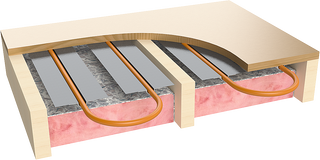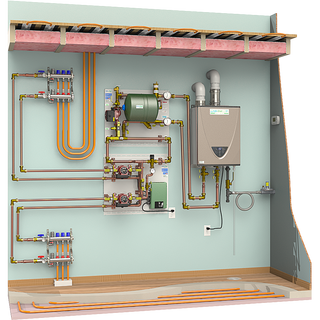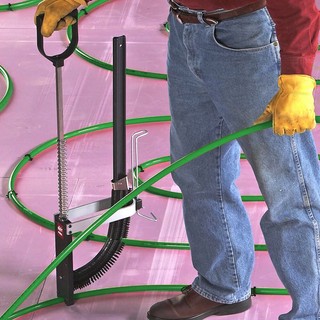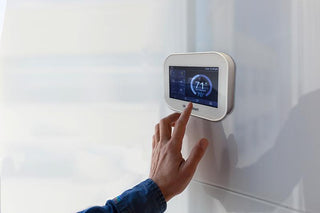

Temp Range: 145° - 180° F / Space Heating Size: Up to 6,300 Sq. Ft.
Staple Up Emitter
Staple up applications require a higher fluid delivery temperature. Unlike concrete, the wooden subfloor will absorb less heat requiring a higher water delivery temperature to be effective in heating the space above.
With a smaller amount of thermal mass compared to concrete, temperature changes (cool down and warm up) take less time. This provides a quicker reaction time to changes in room temperatures. Fluid delivery temperature should not exceed the limits of flooring above the tubing. Damage to the flooring or the emitter itself can occur if temperatures are exceeding past limits.
Always check with flooring manufacturer for heating limits to prevent damage.
When using flooring that requires an epoxy adhesive the temperature of the floor should not exceed 85° F and no higher than 80° for engineered hardwood.
When sizing boiler, Multiply 30 BTU/Sq. Ft. Hr. by total sq. ft. Example: 1200 Sq. Ft. x 30 BTU = 36,000. Your BTU requirements for 1200 Sq. Ft. would be 36,000 BTU, with good insulation quality.
Tubing in Concrete Emitters can only be used with all of our High Temp Gas or Electric Boilers
Benefits of Staple Up

Comfortable
Radiant heat warms the floor, which warms your feet and makes you feel more comfortable.You can feel comfortable walking on the floor barefoot, even in winter.

Efficient
Radiant heat is more efficient than forced-air systems because it minimizes heat loss and uses energy more effectively.

Noise Reduction
Radiant heat systems are quiet, unlike forced-air systems that can be noisy.

Healthy
Radiant heat is healthier than forced-air systems because it doesn't circulate dust and allergens through the air.

Staple Up Components
A vapor barrier is essential as it provides vapor/moisture barrier to help prevent water from coming up from the ground to the concrete.
This requires R-13 fiberglass insulation at the bottom of the joist cavity. An air space of 2” between the top of the insulation and the bottom of the sub floor is necessary. This space will help provide a more even heat across the floor above.
Transfer plates increase the tubing’s ability to transfer heat and distribute it more evenly across the subfloor. Transfer plates, like insulation, will increase system efficiency and provide a return on investment over the life of your system. Transfer plates attach to your floor between the floor joists and hold your tubing in place.
Use only oxygen barrier tubing for a radiant heating system. Spacing for 1/2” tubing is 9-12" on center with a maximum sidewall height of 12 ft. You should have a minimum of R19 wall insulation, R38 ceiling insulation with 2" of extruded styrene insulation under and around the slab. 300’ is the maximum length to avoid too much drop in the water temperature from the beginning to the end of the loop. For zones over 3500 sq. ft. or sidewalls higher than 12 ft., please call Hydro Smart at 1-800-446-2070.
Hydronic Manifolds are cruicial to flow control in a radiant heating system. DO NOT use copper (potable water) manifolds on a radiant heating system. You should have a manfiold for every zone, (Except when zoning by actuators - only 1 Manifold req. for multi zone)






